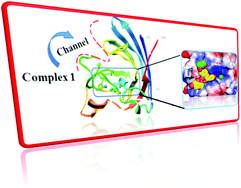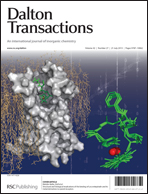New modulated design and synthesis of quercetin–CuII/ZnII–Sn2IV scaffold as anticancer agents: in vitro DNA binding profile, DNA cleavage pathway and Topo-I activity†
Abstract
New molecular topologies quercetin–CuII–Sn2IV and ZnII–Sn2IV1 and 2 were designed and synthesized to act as potential cancer chemotherapeutic agents. Their interaction with CT DNA by UV-vis and fluorescence spectroscopy was evaluated revealing an electrostatic mode of binding. Quercetin complexes are capable of promoting DNA cleavage involving both single and double strand breaks. Complex 1 cleaved pBR322 DNA via an oxidative mechanism while 2 followed a hydrolytic pathway, accessible to the minor groove of the DNA double helix in accordance with molecular docking studies with the DNA duplex of sequence d(CGCGAATTCGCG)2 dodecamer demonstrating that the complex was stabilized by additional electrostatic and hydrogen bonding interactions with the DNA. ROS such as OH˙, H2O2 and O2˙− are the major metabolites responsible for chronic diseases such as cancer, respiratory disorders, HIV, and diabetes etc., therefore eliminating ROS by molecular scaffolds involving SOD enzymatic activity has emerged as a potential way to develop a novel class of drugs. Therefore, in vitro superoxide dismutase activity of redox active complex 1 was evaluated by using a xanthine/xanthine oxidase-NBT assay which showed an IC50 value of 2.26 μM. Moreover, the cytotoxicity of both the complexes were screened on a panel of human carcinoma cell lines (GI50 values <8.7 μM) which revealed that 1 has a better prospect of acting as a cancer chemotherapeutic agent, and to elucidate the mechanism of tumor inhibition, Topo-I enzymatic activity was carried out. Furthermore, molecular modeling studies were carried out to understand molecular features important for drug–enzyme interactions which offer new insights into the experimental model observations.


 Please wait while we load your content...
Please wait while we load your content...